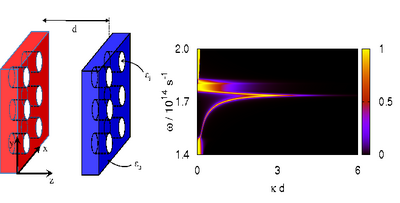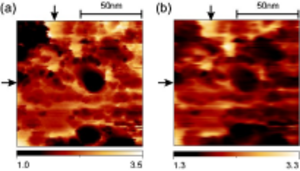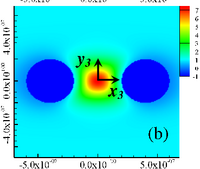Nanoscale thermal radiation
Nanoscale thermal radiation
Thermal near-field radiation of artificial materials
Heat radiation emitted by a medium with a given temperature depends on its material properties, and on its geometry as well. Artificial materials such as nanoporous media, photonic crystals, meta-materials or hyperbolic media feature very unusual optical properties, because of the combined effect of the properties of the respective material itself and of its geometrical structure. For example, by drilling nanoscale holes into a SiC or Au slab, or by ruling a nanoscale grating onto a SiC or Au surface, one can change the optical properties dramatically. This change, in its turn, can enhance or inhibit the heat flow caused by thermal radiation between such media. Therefore, artificial materials allow one to taylor the heat flux. We are investigating not only how the heat flux at the nanoscale can be controlled by such structures, but we also try to give an answer to a much more fundamental question: How does a black body for nanoscale heat radiation look like? And is it possible to artifically manufacture a black body for near-field heat radiation?

- Svend-Age Biehs, Felipe S. S. Rosa, Philippe Ben-Abdallah, Karl Joulain, and Jean-Jacques Greffet:
Nanoscale heat flux between nanoporous materials.
Opt. Expr. Vol. 19, A1088-A1103 (2011).
arXiv:1103.2361v1
- Svend-Age Biehs, Felipe S. S. Rosa, and Philippe Ben-Abdallah:
Modulation of near-field heat transfer between two gratings.
Appl. Phys. Lett. 98, 243102 (2011).
arXiv:1105.3745v1
- Svend-Age Biehs, Philippe Ben-Abdallah, and Felipe S. S. Rosa:
Nanoscale radiative heat transfer and its applications.
chapter 1 in Infrared Radiation (ISBN 979-953-307-349-0), Vasyl Morozhenko (ed.), InTech.
- Svend-Age Biehs, Maria Tschikin, and Philippe Ben-Abdallah:
Hyperbolic Metamaterials as an Analog of a Blackbody in the Near Field.
Phys. Rev. Lett. 109, 104301 (2012).
arXiv:1112.3470v2
Thermal imaging at the nanoscale
We develop a theoretical description of the heat flux between a miniaturized sensing tip and a structured surface of different temperature at nanometer distances. A near-field effect known as “photon tunneling” then allows one to obtain images of the surface. Because such a “photon tunneling microscope” is sensitive to the electromagnetic local density of states, the information acquired in this manner differs from that accessible to a conventional electron tunneling microscope, which maps the electronic local density of states.
This work is performed in close collaboration with the experimental Energy and Semiconductor Research Group headed by Jürgen Parisi. Under the guidance of Achim Kittel, this group has developed a functioning Near-Field Scanning Thermal Microscope (NSThM), which has the unique capability of assessing the extreme near-field regime. Our joint Oldenburg Project aims at a comprehensive understanding of the working principles of this novel instrument. The figures below show a theoretically reconstructed (left) and an experimentally measured (right) thermal image of a nanostructured surface.

- Achim Kittel, Wolfgang Müller-Hirsch, Jürgen Parisi, Svend-Age Biehs, Daniel Reddig, and Martin Holthaus:
Near-Field Heat Transfer in a ScanningThermal Microscope.
Phys. Rev. Lett. 95, 224301 (2005).
arXiv:1103.3278v1
- Svend-Age Biehs, Oliver Huth, and Felix Rüting:
Near-field radiative heat transfer for structured surfaces.
Phys. Rev. B 78, 085414 (2008).
arXiv:1103.3050v1
- Achim Kittel, Uli Wischnath, Joachim Welker, Oliver Huth, Felix Rüting, and Svend-Age Biehs:
Near-field thermal imaging of nano-structured surfaces.
Appl. Phys. Lett. 93, 193109 (2008).
Also selected editorially for the November 24, 2008 issue of the Virtual Journal of Nanoscale Science & Technology.
arXiv:1103.3059v2
- Svend-Age Biehs, Oliver Huth, Felix Rüting and Martin Holthaus:
Spheroidal nanoparticles as thermal near-field sensors.
J. Appl. Phys. 108, 014312 (2010).
arXiv:1103.4511v1
- Felix Rüting, Svend-Age Biehs, Oliver Huth, and Martin Holthaus:
Second-order calculation of the local density of states above a nanostructured surface.
Phys. Rev. B 82, 115443 (2010).
arXiv:1103.3221v1
Cooling of nanoparticles
The heat radiation emitted by a nanoparticle depends strongly on its environment. As for the spontaneous emission of atoms, the heat radiated by a nanoparticle changes tremendously when placing it close to a cold surface. This effect is due to the near-field interaction between the nanoparticle and the surface. This near-field interaction is sensitive to the geometry of the particle (that is, whether its shape is rice corn-like or pancake-like) and to that of the surface (also including surface roughness). In addition, it turns out that many-particle effects (configurational resonances) affect the heat flux between nanoparticles. For instance, the radiative heat flow between two nanoparticles can be controlled (increased and decreased) by introducing a third nanoparticle, due to such configurational resonances.

- Svend-Age Biehs and Jean-Jacques Greffet:
Near-field radiative heat transfer between a nanoparticle and a rough surface.
Phys. Rev. B 81, 245414 (2010).
arXiv:1103.2374v1
- Oliver Huth, Felix Rüting, Svend-Age Biehs, and Martin Holthaus:
Shape-dependence of near-field heat transfer between a spheroidal nanoparticle and a flat surface.
Eur. Phys. J. Appl. Phys. 50, 10603 (2010).
arXiv:1103.5039v1
- Philippe Ben-Abdallah, Svend-Age Biehs, and Karl Joulain:
Many-body radiative heat transfer theory.
Phys. Rev. Lett. 107, 114301 (2011).
arXiv:1107.3646v1
- Maria Tschikin, Svend-Age Biehs, Philippe Ben-Abdallah, Felipe S. S. Rosa:
Radiative cooling of nanoparticles close to a surface.
Eur. Phys. J. B 85, 233 (2012).
arXiv:1112.3470v2


